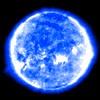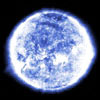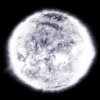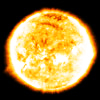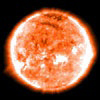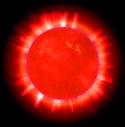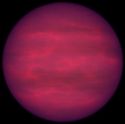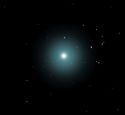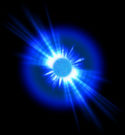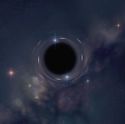Star Type Classification
From Cosmic Fate
Star Types[edit | edit source]
Other Stellar Objects[edit | edit source]
Spectral Type Characteristics[edit | edit source]
Main sequence stars (V)
| Spectral Type | Temperature (K) | Absolute Magnitude | Luminosity (in solar luminosities) |
| O5 | 54,000 | -4.5 | 200,000 |
| O6 | 45,000 | -4.0 | 140,000 |
| O7 | 43,300 | -3.9 | 120,000 |
| O8 | 40,600 | -3.8 | 80,000 |
| O9 | 37,800 | -3.6 | 55,000 |
| B0 | 29,200 | -3.3 | 24,000 |
| B1 | 23,000 | -2.3 | 5550 |
| B2 | 21,000 | -1.9 | 3190 |
| B3 | 17,600 | -1.1 | 1060 |
| B5 | 15,200 | -0.4 | 380 |
| B6 | 14,300 | 0 | 240 |
| B7 | 13,500 | 0.3 | 140 |
| B8 | 12,300 | 0.7 | 73 |
| B9 | 11,400 | 1.1 | 42 |
| A0 | 9600 | 1.5 | 24 |
| A1 | 9330 | 1.7 | 20 |
| A2 | 9040 | 1.8 | 17 |
| A3 | 8750 | 2.0 | 14 |
| A4 | 8480 | 2.1 | 12 |
| A5 | 8310 | 2.2 | 11 |
| A7 | 7920 | 2.4 | 8.8 |
| F0 | 7350 | 3.0 | 5.1 |
| F2 | 7050 | 3.3 | 3.8 |
| F3 | 6850 | 3.5 | 3.2 |
| F5 | 6700 | 3.7 | 2.7 |
| F6 | 6550 | 4.0 | 2.0 |
| F7 | 6400 | 4.3 | 1.5 |
| F8 | 6300 | 4.4 | 1.4 |
| G0 | 6050 | 4.7 | 1.2 |
| G1 | 5930 | 4.9 | 1.1 |
| G2 | 5800 | 5.0 | 1 |
| G5 | 5660 | 5.2 | 0.73 |
| G8 | 5440 | 2.6 | 0.51 |
| K0 | 5240 | 6.0 | 0.38 |
| K1 | 5110 | 6.2 | 0.32 |
| K2 | 4960 | 6.4 | 0.29 |
| K3 | 4800 | 6.7 | 0.24 |
| K4 | 4600 | 7.1 | 0.18 |
| K5 | 4400 | 7.4 | 0.15 |
| K7 | 4000 | 8.1 | 0.11 |
| M0 | 3750 | 8.7 | 0.080 |
| M1 | 3700 | 9.4 | 0.055 |
| M2 | 3600 | 10.1 | 0.035 |
| M3 | 3500 | 10.7 | 0.027 |
| M4 | 3400 | 11.2 | 0.022 |
| M5 | 3200 | 12.3 | 0.011 |
| M6 | 3100 | 13.4 | 0.0051 |
| M7 | 2900 | 13.9 | 0.0032 |
| M8 | 2700 | 14.4 | 0.0020 |
| L0 |
2600 |
* |
0.00029 |
| L3 |
2200 |
* |
0.00013 |
| L8 |
1500 |
* |
0.000032 |
| T2 |
1400 |
* |
0.000025 |
| T6 |
1000 |
* |
0.0000056 |
| T8 |
800 |
* |
0.0000036 |
- - not visible to the human eye (for the most part)
Giants (III)
| Spectral Type | Temperature (K) | Absolute Magnitude | Luminosity (in solar luminosities) |
| G5 | 5010 | 0.7 | 127 |
| G8 | 4870 | 0.6 | 113 |
| K0 | 4720 | 0.5 | 96 |
| K1 | 4580 | 0.4 | 82 |
| K2 | 4460 | 0.2 | 70 |
| K3 | 4210 | 0.1 | 58 |
| K4 | 4010 | 0.0 | 45 |
| K5 | 3780 | -0.2 | 32 |
| M0 | 3660 | -0.4 | 15 |
| M1 | 3600 | -0.5 | 13 |
| M2 | 3500 | -0.6 | 11 |
| M3 | 3300 | -0.7 | 9.5 |
| M4 | 3100 | -0.75 | 7.4 |
| M5 | 2950 | -0.8 | 5.1 |
| M6 | 2800 | -0.9 | 3.3 |
Supergiants (I)
| Spectral Type | Temperature (K) | Absolute Magnitude | Luminosity (in solar luminosities) |
| B0 | 21,000 | -6.4 | 320,000 |
| B1 | 16,000 | -6.4 | 280,000 |
| B2 | 14,000 | -6.4 | 220,000 |
| B3 | 12,800 | -6.3 | 180,000 |
| B5 | 11,500 | -6.3 | 140,000 |
| B6 | 11,000 | -6.3 | 98,000 |
| B7 | 10,500 | -6.3 | 82,000 |
| B8 | 10,000 | -6.2 | 73,000 |
| B9 | 9700 | -6.2 | 61,000 |
| A0 | 9400 | -6.2 | 50,600 |
| A1 | 9100 | -6.2 | 44,000 |
| A2 | 8900 | -6.2 | 40,000 |
| A5 | 8300 | -6.1 | 36,000 |
| F0 | 7500 | -6 | 20,000 |
| F2 | 7200 | -6 | 18,000 |
| F5 | 6800 | -5.9 | 16,000 |
| F8 | 6150 | -5.9 | 12,000 |
| G0 | 5800 | -5.9 | 9600 |
| G2 | 5500 | -5.8 | 9500 |
| G5 | 5100 | -5.8 | 9800 |
| G8 | 5050 | -5.7 | 11,000 |
| K0 | 4900 | -5.7 | 12,000 |
| K1 | 4700 | -5.6 | 13,500 |
| K2 | 4500 | -5.6 | 15,200 |
| K3 | 4300 | -5.6 | 17,000 |
| K4 | 4100 | -5.5 | 18,300 |
| K5 | 3750 | -5.5 | 20,000 |
| M0 | 3660 | -5.3 | 50,600 |
| M1 | 3600 | -5.3 | 52,000 |
| M2 | 3500 | -5.3 | 53,000 |
| M3 | 3300 | -5.3 | 54,000 |
| M4 | 3100 | -5.2 | 56,000 |
| M5 | 2950 | -5.2 | 58,000 |
